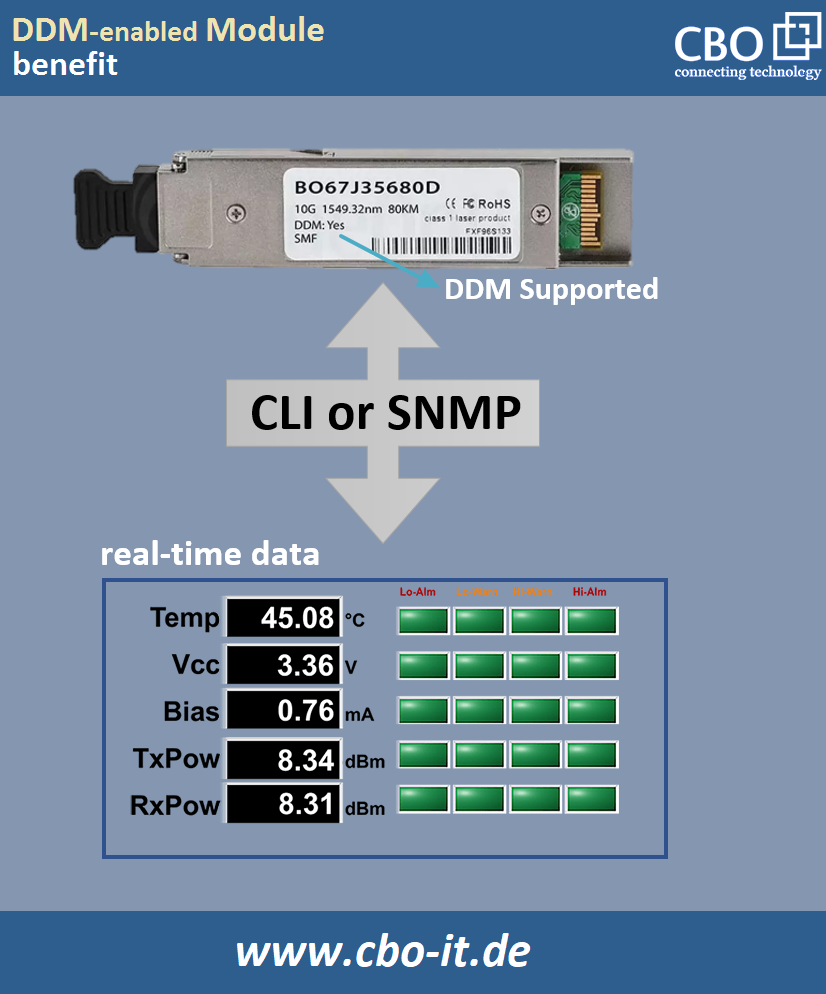Have you ever wondered what DDM stands for when you buy an optical transceiver? If you don't know much about it, don't worry, because that's exactly what we're going to discuss in this post! Call it DDM or DOM. Both are the same thing. However, DOM (Digital Optical Monitoring) is a term more commonly used for QSFP and CFP modules. DDM is a technology that is integrated into GBIC-based optical modules. With this technology, we can monitor the operating parameters of the transceiver in real time.
What makes up the DDM structure?
The entire DDM framework is outlined and specified by SFF-8472 - MSA (Multisource Agreement). SFF-8472 contains all specifications for vendors manufacturing DDM-enabled optical modules. Revision 12.2 is the latest version of SFF-8472 that is valid today.
What information is offered by DDM?
Digital Diagnostic Monitoring (DDM) monitors and provides access to five important parameters of optical transceivers. These parameters are;
- Rx power
- Tx power
- Laser bias voltage
- Operating voltage
- Operating temperature
How can we access the DDM interface?
There are two ways to access the DDM interface of a fiber optic module;
- through CLI
- through SNMP
The simplest and easiest way to access digital diagnostics is to use the CLI of the host network device (router, switch, etc.). However, to use this function, you must ensure that your network device is configured to allow the DDM function.

The second method for accessing the DDM information and interface is of a more technical nature and allows you to view the operating parameters of your module. SNMP stands for Simple Network Management Protocol.
Typical applications of digital diagnostics Monitoring
DDM is very helpful in several ways. It provides live operating parameters of transceivers - information that we can use to learn about the condition of our modules. In addition, the information contained in digital diagnostic monitoring can be used to predict the lifetime of the module. The three most common applications of DDM are described below;
Lifespan module Life assessment
In general, optical transceivers play a very important role in any fiber optic network. The failure of a single optical transceiver can result in the interruption of a connection. In today's highly competitive environment, network service providers can imagine very little downtime. Therefore, keeping an eye on the degrading optical transceivers in your network is an important but difficult task. However, DDM technology can help us to effectively monitor our SFP and SFP+ transceivers. All five parameters included in DDM monitoring are critical, and each of them can indicate the prevailing transceiver health issues. Take laser bias current, for example, whose elevated values can indicate a rapid decrease in the quantum efficiency of the laser and subsequent failure of the optical module.
Real-time monitoring
DDM-enabled optical transceivers provide you with real-time live monitoring of multiple parameters. This real-time monitoring allows users to track the health of their critical network resources. It is important to understand that you need to configure your transceivers to log data in real time. In addition, the DDM-enabled transceivers can generate and send log messages in the event of deviations between operating parameters and their target values.
Multi-level alarms
DDM-compatible optical transceivers have an integrated alarm scheme defined in the relevant standard. Typically, manufacturers supply optical transceivers with preset high/high-high and low/low-low thresholds for each of the five parameters in the DDM monitoring scheme. This means that if the control system of your DDM-enabled transceiver receives a value that deviates from the high or low threshold, a warning is issued. Similarly, if the second threshold or the high threshold is exceeded, the control system will generate an "alarm". Some manufacturers design their products so that the transceivers switch off their transmit and receive ports if they detect that one of their parameters is in the alarm range.
Conclusion
In this post, we have discussed that DDM is a very efficient technology for the protection and longevity of optical modules. Let us now summarize in light of the above facts;
- DDM is a wonderful technology, but we don't get it in every module. Understandably, modules with DDM quality are better than those that don't have DDM quality.
- These modules alert you to problems and health conditions in real time, so you can fix them in time.
- With the help of this technology, you can also receive information about the current status of your optical transceivers remotely.
- There are two ways to access the DDM interface of a capable module: via the command line interface (CLI) and via SNMP.
 English
English
 Deutsch
Deutsch
 Espaniol
Espaniol










